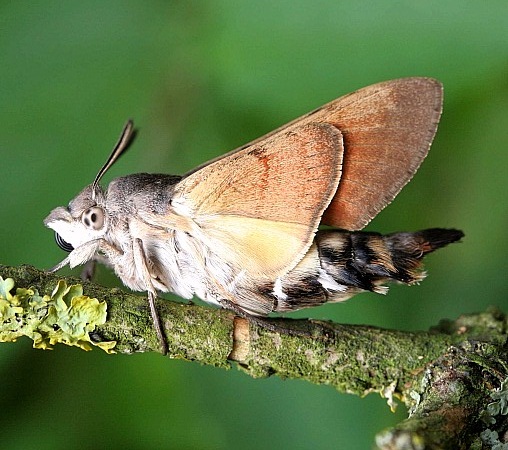

The most commonly observed hummingbird-like moth is the whitelined sphinx, Hyles lineata, so named for the broad white stripe running diagonally to the outer tip of each front wing. The rolling and unrolling action of the proboscis can be compared to the movements of a party noisemaker. When the moth is done feeding, muscles coil the proboscis back into resting position. The tightly spiraled proboscis is extended and held stiff by internal fluid pressure as the moth reaches for the nectar supply at the base of flowers. When not in use the proboscis is coiled against the underside of the head. The well-developed proboscis of hummingbird moths is an extendable, beaklike hollow tube or tongue that may be several inches in length and often as long as or longer than the moth’s body. A tiny amount of nectar is withdrawn during a brief visit to each flower. They are capable of hovering in mid air for extended periods and flying just in front of flowers as they sip nectar through their extended proboscis. Sphinx moths are strong fliers with a very rapid wingbeat. There are approximately 125 different species of sphinx moths in the U.S. Sphinx moths may have a wingspread of up to 6 inches though a more common size in Iowa is a 2 to 4.5 inch wingspan. The wings have the shape of a wide, flat triangle ending in an acute angle at the farthest point. These are medium to large-sized moths with a robust body and narrow, elongate front wings. Sphinx moths, also known as hawk moths, are from the family Sphingidae. The name hummingbird moth is a nickname used for several different species of sphinx moths.


If you don’t look closely at the dark color and the antennae at the front of the head, you can be easily fooled into believing these really are hummingbirds! They hover in mid-air and flit from one flower to the next. However, it is remarkable how much the moths behave like hummingbirds. The moths in question are large and about the size of a hummingbird. Favorite flowers include deep-throated blossoms such as petunias and hosta blooms. One of my favorites is the large dark moths that look and act like hummingbirds, feeding on nectar from flowers around dusk. There is so much to enjoy in late summer.


 0 kommentar(er)
0 kommentar(er)
